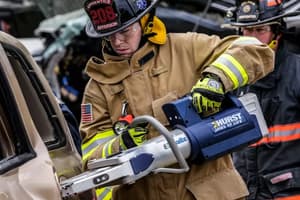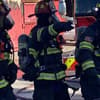Podcast
Questions and Answers
Define extrication.
Define extrication.
Extrication is the removal and treatment of a patient(s) trapped by machinery or equipment.
What are the phases of extrication? Choose the correct option.
What are the phases of extrication? Choose the correct option.
- Prevention & Mitigation
- Hazard Assessment & Size-up; Hazard Control & Incident Stabilization; Gaining Access & Patient Assessment; Disentanglement; Patient Packaging; Extrication (correct)
- Incident Detection & Reporting
- Patient Treatment & Recovery
What are the two criteria that define the success of an extrication operation?
What are the two criteria that define the success of an extrication operation?
Effectiveness and Safety
Rescue involves placing a patient in an untenable or unhealthy situation. True or False?
Rescue involves placing a patient in an untenable or unhealthy situation. True or False?
Define AHJ and SOPs/SOGs. AHJ stands for ___________.
Define AHJ and SOPs/SOGs. AHJ stands for ___________.
Which standards relate to managing an extrication incident?
Which standards relate to managing an extrication incident?
Operational assignments for personnel should consider competence, physical strength, and emotional stability.
Operational assignments for personnel should consider competence, physical strength, and emotional stability.
HSPD-5 directs federal, state, local, and tribal entities to operate with the NIMS-ICS system to ensure an incident management system will interface with _______ response agencies during an emergency.
HSPD-5 directs federal, state, local, and tribal entities to operate with the NIMS-ICS system to ensure an incident management system will interface with _______ response agencies during an emergency.
Match the extrication group with their responsibilities:
Match the extrication group with their responsibilities:
What is the purpose of After Action Reviews?
What is the purpose of After Action Reviews?
Which of the following are types of respiratory equipment commonly used at rescue/extrication emergencies?
Which of the following are types of respiratory equipment commonly used at rescue/extrication emergencies?
Rescuers must develop the skills necessary for safe extrication. They should resist the urge to rush in and instead ______________ safety needs.
Rescuers must develop the skills necessary for safe extrication. They should resist the urge to rush in and instead ______________ safety needs.
Size-up is defined as a one-time evaluation process of the incident and response efforts.
Size-up is defined as a one-time evaluation process of the incident and response efforts.
What are some of the risks managed by rescuers during a rescue/extrication operation?
What are some of the risks managed by rescuers during a rescue/extrication operation?
What is the incident's medical component focused on?
What is the incident's medical component focused on?
______ilitation stations should be established at every prolonged operation due to heavy labor, environmental conditions, accumulated activity, and other health & safety factors.
______ilitation stations should be established at every prolonged operation due to heavy labor, environmental conditions, accumulated activity, and other health & safety factors.
Incident Safety Officers (ISO) are required during extrication operations for ongoing assessment of incident actions and conditions.
Incident Safety Officers (ISO) are required during extrication operations for ongoing assessment of incident actions and conditions.
Match the following elements of emergency extrication response with their descriptions:
Match the following elements of emergency extrication response with their descriptions:
What are the three incident priorities in Extrication Incident Management?
What are the three incident priorities in Extrication Incident Management?
What determines the level of Incident Management required for an extrication incident?
What determines the level of Incident Management required for an extrication incident?
Command & Control groups are based on incident needs, while they may be ______ as needed.
Command & Control groups are based on incident needs, while they may be ______ as needed.
Vehicle stabilization aims to prevent movement of the vehicle in only one direction.
Vehicle stabilization aims to prevent movement of the vehicle in only one direction.
Match the following Control Zones with their descriptions:
Match the following Control Zones with their descriptions:
Which vehicle construction method is known as body-on-frame construction?
Which vehicle construction method is known as body-on-frame construction?
Unibody construction is also referred to as 'integral frame'.
Unibody construction is also referred to as 'integral frame'.
What is the primary purpose of a space frame in vehicle design?
What is the primary purpose of a space frame in vehicle design?
Pretensioners instantly tighten the seat _ for maximum benefit.
Pretensioners instantly tighten the seat _ for maximum benefit.
What are some common types of passenger vehicles, cars, and light trucks?
What are some common types of passenger vehicles, cars, and light trucks?
Match the following airbag descriptions with their correct side:
Match the following airbag descriptions with their correct side:
What are some types of medium and heavy trucks?
What are some types of medium and heavy trucks?
A Type A school bus has a seating capacity of approximately 8 people.
A Type A school bus has a seating capacity of approximately 8 people.
Buses transport large numbers of people locally and regionally for _____ purposes.
Buses transport large numbers of people locally and regionally for _____ purposes.
Match the heavy equipment/machinery with their names:
Match the heavy equipment/machinery with their names:
What are the two main types of battery systems in use?
What are the two main types of battery systems in use?
BATTERY Locations - Under hood, Trunk, Rear seat, Wheel well. Hazards include acid, disconnecting, and cutting cables, under the ________.
BATTERY Locations - Under hood, Trunk, Rear seat, Wheel well. Hazards include acid, disconnecting, and cutting cables, under the ________.
The higher the center of gravity (COG), the less susceptible to rollover.
The higher the center of gravity (COG), the less susceptible to rollover.
Match the vehicle collision type with its description:
Match the vehicle collision type with its description:
What standard must helmets meet for extrication?
What standard must helmets meet for extrication?
What is the most common protection for the face during extrication?
What is the most common protection for the face during extrication?
Proper fit of foot protection is not important for responders.
Proper fit of foot protection is not important for responders.
OSHA requires the use of hearing protection at or over ______ dB.
OSHA requires the use of hearing protection at or over ______ dB.
Match the respiratory protection with its description:
Match the respiratory protection with its description:
Flashcards are hidden until you start studying
Study Notes
Introduction to Vehicle Extrication
- Vehicle extrication is the removal and treatment of patients trapped by machinery or equipment.
- Disentanglement is the manipulation of vehicle or machinery components to provide for the removal of a packaged patient(s).
- Rescue is the removal of a patient from an untenable or unhealthy situation or atmosphere.
Phases of Extrication
- Hazard Assessment & Size-up
- Hazard Control & Incident Stabilization
- Gaining Access & Patient Assessment
- Disentanglement
- Patient Packaging
- Extrication
Organizations Specific to Extrication
- USDOT: Develops and coordinates policies and programs designed to protect and improve the U.S. transportation system.
- NHTSA: Sets and enforces safety standards, and funds state and local highway safety programs.
- IIHS: Evaluates crash avoidance and crashworthiness of vehicles, and evaluates physical and environmental factors.
- ANSI: Manages voluntary standardization and facilitates development of standards.
- NFPA: Develops technical consensus standards, and develops fire training and public education materials.
- Transport Canada: Primary regulatory agency of vehicle and highway safety in Canada, and works with other partners to provide vehicle safety information.
- TERC: Provides guidance on transportation for emergency services, and has several goals.
- NTSB: Responsible for determining probable causes of transportation accidents.
Rescue Organization Responsibilities
- Conform to laws and regulations, and ensure member training is nationally recognized and appropriate.
- Conduct hazard/risk assessment surveys, and develop written response plans (SOP/SOG).
- Set minimum entrance requirements, and determine response/operational capabilities.
- Provide training opportunities for personnel, and provide required equipment and PPE.
- Establish a Safety Program.
AHJ and SOP Concepts
- AHJ: Authority Having Jurisdiction, and SOP: Standard Operating Procedures.
Hazard and Risk Assessment
- A formal review of potential and probable hazards and risks that may be encountered while performing key functions during a rescue/extrication emergency.
- Identify potential hazards, assess the level of risk within the response area, and determine the possible and probable rescue situations that could occur within the response area.
- Many levels of government perform Regional Vulnerability Studies.
Written Response Plans
- Provide a method for implementing changes and revisions, and must be formally reviewed and adopted.
- Updated as required, and provide a method for implementing changes and revisions.
Operational Capabilities
- Hazard/risk assessment, personnel training, and internal/external resources.
Extrication Equipment
- Identify equipment and resources available internally and externally, and acquire equipment applicable to the organization's response level and capability.
- Maintain equipment in accordance with manufacturer's recommendations.
Extrication PPE
- Must be selected and suited for the anticipated hazards and risks, and personnel should be trained in the capabilities and limitations of their PPE.
- Personnel require training in inspection, care and maintenance, and use and operation of PPE.
Respiratory Protection
- May be required for certain extrication incidents, such as WMD, fire & explosion potential, bio-hazards, and IDLH environments.
- Types of respiratory equipment commonly used at rescue/extrication emergencies include SAR, APR, PAPR, and SCBA.
After Action Reports
- Serve two main purposes: improve organizational operations and processes, and identify strengths and weaknesses.
- Also known as Post Incident Analysis (PIA), and an evaluation tool used for project or incident improvement.
Size-up
- Defined as an ongoing evaluation process of the incident and response efforts, and results in a dynamic plan of action.
- Assesses all possible conditions, contributing factors, and resource requirements.
Size-up Considerations
-
Rescue or Recovery, risk/hazard analysis, and safety & survival priorities (self, fellow rescuers, bystanders, and patients).
-
An effective risk assessment and hazard identification and control process sets the stage for success.### Vehicle Extrication
-
Vehicle extrication involves most emergency response organizations, emphasizing the importance of following regional and national standards for safety.
Critical Skill Sets
- Safe use of equipment and tools for rescuer protection
- On-scene medical care and patient packaging
- Accessing patients, assessing, and transferring them to EMS in safe condition
Extrication Incident Action Priorities
- Life Safety: personnel safety, patients, and bystanders
- Incident Stabilization: scene control, vehicle stabilization, patient stabilization, and hazard elimination
- Property & Environmental Conservation: minimizing damage, implementing non-destructive methods, and securing unprotected property
- After Action Review: evaluating response actions, identifying strengths and weaknesses, and learning from experiences
Incident Roles & Responsibilities
- Rescue Group: vehicle stabilization, patient access, stabilization, disentanglement, and packaged patient removal
- Law Enforcement Group: traffic control, crowd control, and investigation
- EMS Group: patient evaluation, treatment, and transportation
- Fire Suppression Group: fire protection, ignition control, and scene protection
Extrication Incident Management
- Identify standards that relate to managing an extrication incident
- Identify basic facts about safety requirements for extrication incidents
- Describe the importance of training to extrication incident safety
Learning Objectives
- Identify key components of an extrication operation
- Describe the duties performed by extrication personnel
- Identify facts about the early stages of an emergency extrication response
- Describe the duties performed by outside agencies during an extrication operation
Extrication Standards
- NFPA 1670: Training & Response Levels
- NFPA 1006: Minimum standards for professional certification testing for Technical Rescue
- NFPA 1500: Fire Department Occupational Safety & Health
- NFPA 1561: Emergency Services Incident Management System
Presidential Directive
- HSPD-5: directs federal, state, local, and tribal entities to operate with the NIMS-ICS system
Extrication Incident Safety
- Success is defined by effectiveness and safety
- A safe extrication environment begins with key elements that may expand during the operation
- Incident Action Plans must be dynamic and flexible to meet the challenges of the incident
Training
- Training provides essential knowledge and skill sets to rescue personnel
- Working knowledge of strategies, tools, and techniques
- How to function as a team member
- SOPs and pre-incident plans must be practiced during training
Operational Assignments
- Assignments are based on contributing factors related to the incident
- Match the most qualified and capable crew members to the assigned task(s)
- Ongoing assessment of progress
Medical Component
- Risks are managed through training, experience, probable outcomes, equipment reliability, and procedural safety margins
- Medical component is focused on triage, treatment, and transportation
- BLS unit should be readily available to manage potential rescuer injuries
Rehabilitation (Rehab)
- Rehab stations should be established at every prolonged operation
- Contributing factors: heavy labor, environmental conditions, accumulated activity, and other health & safety factors
- Rehab focus areas: rest, rehydration, medical evaluations, and crew rotation
Mitigating Potential Hazards
- Common extrication hazards: traffic, utilities, vehicle fluids, hazardous materials, and damaged or involved vehicles
- When addressing hazard management strategies, consider the patient(s) condition and exposure
- Scene control is critical to prevent injuries and risks
Incident Safety Officer (ISO)
- An Incident Safety Officer (ISO) is required during extrication operations
- Performs an ongoing assessment of incident actions and conditions
- ISO should have a working knowledge of hazards, strategies, tactics, tools, and equipment
Personnel Accountability
- Required for effective and safe scene management
- Accountability needs to become part of the organization's response culture
- Use accountability procedures during training sessions
Emergency Extrication Response
- Technology enhancements have increased the amount and level of information received during extrication emergencies
- Implementing the response: pre-incident planning, standardized responses, and resource capabilities### Size-up and Incident Assessment
- Observe variables on the scene to decide if more resources are needed
- Assess for specialized resources (task force): Hazmat, Technical Rescue, Suppression
- Consider vehicle(s): position, stability, condition, and mechanism of injury
Assessment of Patients
- Requires a more detailed evaluation of injuries and entrapment factors
- Patients can extend beyond the involved vehicle areas
- Access to patients cannot begin until hazards are controlled and vehicles are stabilized
- Requires a risk/benefit decision-making process
Triage
- Key assessment areas: number of patients, injuries, and entrapment conditions
- Establish medical priorities
- Required transportation services: land, air, water
Extrication Assessment
- Task/resource assessment process
- Goal: execute a safe and quick extrication
- Provides critical information to support response decisions
- Resource management includes both personnel and equipment
Patient Removal Assessment
- Two primary methodologies: normal (standard) extrication and rapid extrication
- Normal extrication: concept of first removing the vehicle or machinery components away from the patient
- Rapid extrication: used only in emergency life-threatening situations, removal of patient in the first priority
Incident Management
- Purpose: organize the response to enhance safety, efficiency, and effectiveness
- Working within an IMS should be routine to responders
- The first arriving unit should initiate an IMS: Single Command Structure, Unified Command Structure
Incident Priorities
- Provide for safety and survival regarding response personnel
- Prevent further injuries to others
- Rescue those who can be saved
- Recover the remains of those who cannot be saved
Control Zones
- Restricted (hot) Zone: high hazard area, limited access
- Limited Access (warm) Zone: limited risk or exposure to hazards
- Support (cold) Zone: unlikely risk or exposure to hazards
Command and Control
- Groups based on incident needs: Rescue/Extrication, Medical, Suppression, Law Enforcement
- The IC establishes the level of command and control
Managing Environmental Exposures
- Identify possible shelter in pre-planning
- Protect patients and responders from environmental hazards
- Temporary shelters: provide protection from the environment
Apparatus Placement
- Shadow vehicle: place apparatus in a safe location
- Protect patients and responders from apparatus hazards
Traffic Control
- Control traffic to prevent hazards to responders and patients
- Route traffic into unobstructed lanes or areas
- Be cautious when moving about the incident
Control Zones
- Restricted (hot) Zone: high hazard area, limited access
- Limited Access (warm) Zone: limited risk or exposure to hazards
- Support (cold) Zone: unlikely risk or exposure to hazards
Extrication
- Performed after all potential hazards are mitigated
- Patient considerations: access, egress, disentanglement, and extrication
- Develop an extrication plan: prioritize patient access and removal, develop a treatment and patient packaging strategy
Vehicle Stabilization
- Goal: prevent unwanted movement of the vehicle
- Utilize ropes, chains, cribbing, shoring, and chocks
Vehicle Access and Egress Points
- Determine the best strategy to provide vehicle access for medical personnel
- Determine the safest route for removing packaged patients
Studying That Suits You
Use AI to generate personalized quizzes and flashcards to suit your learning preferences.





